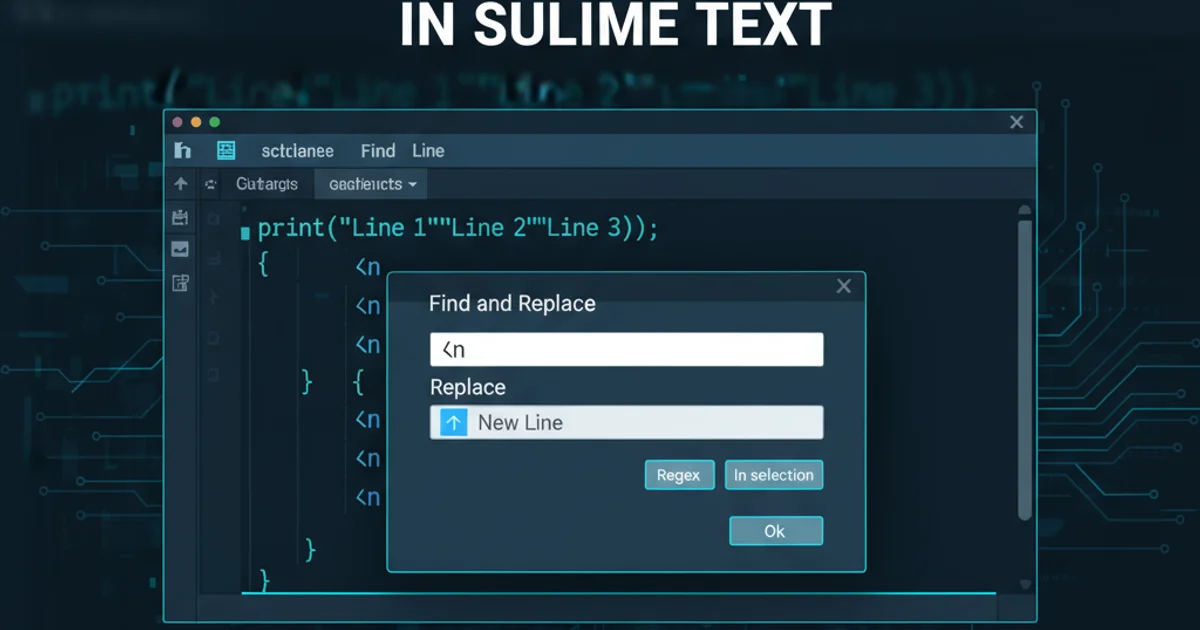Replace \n with actual new line in Sublime Text
Categories:
Replacing '\n' with Actual Newlines in Sublime Text

Learn how to effectively convert the literal string '\n' into actual line breaks within Sublime Text using its powerful find and replace features.
When working with text files, especially those generated by scripts or exported from databases, you might encounter situations where newline characters are represented literally as the two-character string \n instead of creating an actual line break. This can make the content difficult to read and parse. Sublime Text offers robust find and replace functionalities that can handle this common issue efficiently.
Understanding the Problem: Literal vs. Actual Newlines
The core of the problem lies in the distinction between a literal string \n and the actual newline character (ASCII Line Feed, LF, or Carriage Return + Line Feed, CRLF). Many programming languages and systems use \n as an escape sequence to represent a newline. However, when this sequence is stored or displayed as plain text without proper interpretation, it appears as two distinct characters: a backslash and the letter 'n'.
Sublime Text's find and replace feature, particularly with 'Regular Expression' mode enabled, allows you to treat \n as the special character it represents, enabling you to perform the desired conversion.
flowchart TD
A[Input Text with Literal \n] --> B{"Sublime Text Find/Replace"}
B --> C{Enable 'Regular Expression'}
C --> D[Find: \\n]
D --> E[Replace: \n]
E --> F[Execute Replace All]
F --> G[Output Text with Actual Newlines]Process flow for replacing literal '\n' with actual newlines in Sublime Text.
Step-by-Step Guide to Replacement
Converting \n to actual newlines in Sublime Text is a straightforward process once you know which options to enable. This method leverages regular expressions to interpret the escape sequence correctly.
1. Open the Find and Replace Panel
In Sublime Text, press Ctrl+H (Windows/Linux) or Cmd+Option+F (macOS) to open the 'Find and Replace' panel. Alternatively, go to Find > Replace... from the menu bar.
2. Enter the Find String
In the 'Find' field, type \\n. It's crucial to use two backslashes (\\) because the first backslash escapes the second, telling the regular expression engine that you are looking for a literal backslash followed by an 'n'.
3. Enter the Replace String
In the 'Replace' field, type \n. Here, a single backslash is used because, with regular expressions enabled, \n will be interpreted as an actual newline character.
4. Enable Regular Expression Mode
Click the 'Regular Expression' button in the Find and Replace panel. This button typically looks like .* or RegEx. It's essential for Sublime Text to interpret \n as a special character rather than a literal string.
5. Execute the Replacement
Click 'Replace All' to convert all occurrences of \n in your document to actual newlines. You can also use 'Find' and 'Replace' individually to review changes one by one.
Original text:
Line 1\nLine 2\nLine 3
After replacement:
Line 1
Line 2
Line 3
Example of text before and after the replacement operation.
Handling Other Escape Sequences
The same technique can be applied to replace other common escape sequences if they appear literally in your text. For example:
\t(literal tab) to an actual tab character: Find\\t, Replace\t\r(literal carriage return) to an actual carriage return: Find\\r, Replace\r
Remember to always enable 'Regular Expression' mode for these replacements to work as intended.